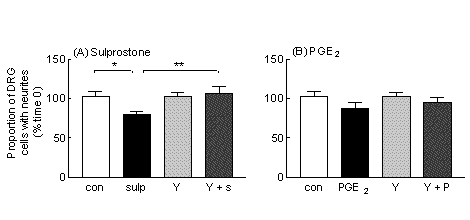| pA2 online © Copyright 2004 The British Pharmacological Society |
137P
GKT, University of London Winter Meeting December 2003 |
|
Rho kinase-dependent
neurite retraction by prostaglandin EP3
receptor agonist in rat dorsal root ganglion cells, in vitro |
|
The EP3 subtype of prostaglandin E2 (PGE2) receptor has been identified by immunohistochemistry in rat dorsal root ganglia (DRG), where it is localised to nociceptive neurones (Nakamura et al., 2000). In addition to inhibiting adenylyl cyclase activity through coupling to Gi EP3 receptors also couple to G12/13 resulting in Rho-kinase dependent retraction of neurites (Hatae et al., 2002). The aim of the present study was to determine if activation of EP3 receptors endogenously expressed by rat DRG cells similarly caused neurite retraction, and to compare the effects of PGE2 with the EP3/1 receptor agonist sulprostone.
The dorsal root ganglia were removed from all levels of the spinal cord of male Sprague-Dawley rats (150 - 200 g) and cultures were prepared as described previously (Rowlands et al., 2001). DRG cells were plated at 5,000 cells per 22 mm glass coverslip pretreated with poly-DL-ornithine (500 µg/ml) and laminin (5 µg/ml), and incubated in F14 medium containing Ultroser G (4%, v/v) and arabinoside C (10 µM). The proportion of DRG cells with neurites was determined by counting a minimum of 100 cells per well, and cells with processes at least the diameter of the cell body in length were counted as neurite bearing. The assay was performed 40 h after cell isolation, with the Rho-kinase inhibitor Y27632 (Tocris) added 15 min before PGE2 or sulprostone.
Results show that after 1 h incubation with sulprostone (1 µM) the proportion of DRG cells bearing neurites was decreased by 22%, and this effect was inhibited by Y27632 (Fig. 1A). The inhibitory effect of sulprostone was lost by 4 h. PGE2 (1 µM; Fig. 1B) had no statistically-significant effect, and neither sulprostone (1 nM) nor PGE2 (1 nM) were active in this assay.
Figure 1. Effect of Y27632 (1 µM) on sulprostone (1 µM) and PGE2 (1 µM)-mediated changes in neurite extension at 1 h following addition of agonist.

In conclusion, sulprostone inhibits neurite extension by rat DRG cells in a Rho-kinase-dependent manner, but the endogenous ligand PGE2 does not. Therefore, the functional role of EP3 receptors on nociceptive neurones remains to be clarified.
Hatae, N., Sugimoto,
Y., Ichikawa, A. (2002) J. Biochem. 131, 781-784.
Nakamura, K. et al. (2000) J. Comp. Neurol. 421, 543-569.
Rowlands, D.W., Kao, C.L., Wise, H. (2001) Br. J. Pharmacol. 133,
13-22.
This work was supported by the Research Grants Council of the Hong Kong SAR (CA99/00.SC1).